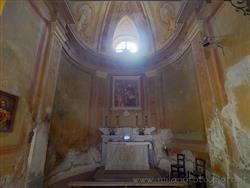|
Campiglia Cervo (Biella)- Chapel of Ritert
|
|
|
Show to visit in the Biella area: |
 The Ritert Chapel, also known as the Oratory of the Madonna of Riterto or also the Oratory of San Rocco and of Our Lady of Sorrows, is located along the road that connects Campiglia Cervo in the strict sense with its fraction Valmosca and is characteristic for the portico crossing the road, which on the other side of the road also covers a rest stop for wayfarers. The Ritert Chapel, also known as the Oratory of the Madonna of Riterto or also the Oratory of San Rocco and of Our Lady of Sorrows, is located along the road that connects Campiglia Cervo in the strict sense with its fraction Valmosca and is characteristic for the portico crossing the road, which on the other side of the road also covers a rest stop for wayfarers.
The chapel was built by the population in 1641 (but according to other sources the first version dates back even to the beginning of the sixteenth century), in thanksgiving for the ceased danger of the plague, which had spread since 1629. The plague had claimed many victims in the Valley, so much so that the community had to resort to Swiss monks from Zermatt to transport the corpses to the mass graves in the cemetery.
The current version of the chapel dates back to 1821, when it was rebuilt in its current form by the master Giorgio Guidetti and the painter Boggio for the pictorial part.
The chapel is built entirely of hewn granite stones. They are visible, except on the facade, which is plastered. The latter is delimited laterally by double pilasters superimposed which at the apex also support the beams of the roof which crosses the roadway.
The chapel includes a square room with a cross vault and a semicircular apse as wide as the whole chapel and equipped with a cardioid-shaped window in the upper centre.
Internally the chapel is much richer than one would be led to expect. The walls are punctuated by pilasters and the transition from the walls to the ceiling is underlined by a double frame with a band painted in the center in imitation of marble.
All surfaces are decorated with frescoes in a style typical for the first half of the nineteenth century: frames, trompe l'oeil stuccos, branches and stylized plant elements. From the style one would think that they were painted in the nineteenth century. The interior is not particularly dark because, in addition to the window in the apse, there are two rectangular windows (although almost completely obscured by wooden shutters) on the sides of the entrance, an oculus at the top of the facade and a rectangular window in the left wall, which corresponds, on the opposite wall, to simulate symmetry, to the fresco of a window with the same characteristics.
At the bottom of the apse, above the stone altar, there is, within a frame formed by a band with a geometric motif, a fresco from the early sixteenth century work of an artist of the Novara area and depicting the Virgin with the deposed Christ and, on the left, San Rocco. The ancient fresco is also highlighted by a shelf placed just below it supported also by a cherub's head, in the centre.
Categories: Places of historical value of artistic value
45.666510, 7.993508 |
Chapel of Ritert: Further pictures in the section Photography |